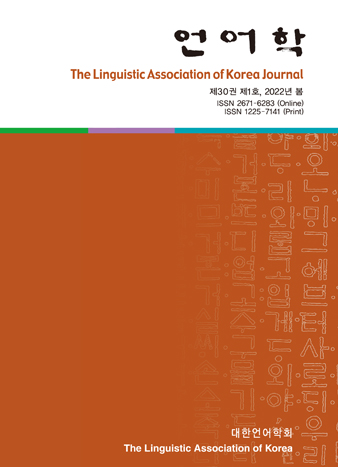대한언어학회 전자저널

30권 1호 (2022년 3월)
- Numeral Classifiers in Eastern Tamang
-
Michael Jonathan Mathew Barrie · Jaehyun Jun
Pages : 113-131
Abstract
Barrie, Michael Jonathan Mathew & Jun, Jaehyun. (2022). Numeral classifiers in Eastern Tamang. The Linguistic Association of Korea Journal, 30(1), 113-131. In this paper, we examine numeral classifiers and number marking in one dialect of Eastern Tamang. As Tamang is a relatively understudied dialect continuum, we give a basic description of the empirical facts. We then employ various diagnostics from the literature and one we created ourselves to determine whether classifiers compose with nouns or with numerals. We conclude that since the classifier composes with numerals, the numeral classifier is a constituent that composes with the NP. We also examine number marking and observe that the plural marker is obligatory in some environments for animate nouns, but not for inanimate nouns. We conclude by making some tentative remarks that this dialect of Eastern Tamang might be undergoing a transition from a classifier language to a number language.
Keywords
# numeral classifiers # Tamang # number # language change
References
- Aikhenvald, A. Y. (2003). Classifiers: A typology of noun categorization devices. Oxford: Oxford University Press.
- Bale, A., & Coon, J. (2014). Classifiers are for numerals, not for nouns: Consequences for the mass/count distinction. Linguistic Inquiry, 45(4), 695-707.
- Borer, H. (2005). Structuring Sense, volume 1: In Name Only. Oxford: Oxford University Press.
- Cheng, L. L. S., & Sybesma, R. (1988). Yi-wan tang, yi-ge tang: Classifiers and massifiers. Tsing-Hua Journal of Chinese Studies, 28(3), 385-412.
- Chierchia, G. (1998). Reference to kinds across languages. Natural Language Semantics, 6(4), 339-405.
- Corbett, G. G. (2000). Number. Cambridge: Cambridge University Press.
- Greenberg, J. (1977). Numeral classifiers and substantival number: Problems in the genesis of a linguistic type. In A. Makkai, V. Becker Makkai, & L. Heilmann (Eds.), Linguistics at the crossroads (pp. 276-300). Lake Bluff, IL: Jupiter Press.
- Jenks, P. (2017). Numeral classifiers compete with number marking: Evidence from Dafing. Paper presented at the Annual Meeting of the Linguistic Association of America, Austin, Texas, 5-8, January.
- Kim, K. (2009). On the distribution of the Korean plural marker tul. The Journal of Studies in Language, 24(4), 665-684.
- Kim, K., & Melchin, P. B. (2018). Modifying plurals, classifiers, and co-occurrence: The case of Korean. Glossa, 3(1), 25.
- Kim, K., and Melchin, P. B. (2018). On the complementary distribution of plurals and classifiers in East Asian classifier languages. Language and Linguistics Compass, 12: e12271.
- Kim, Y.-H. (2009). The syntax of the plural marker -tul and classifiers in Korean. Korean Journal of Linguistics, 34(4), 829-852.
- Krifka, M. (1995). Common nouns: A contrastive analysis of English and Chinese. In G. N. Carlson & F. J. Pelletier (Eds.), The generic book (pp. 398-411). Chicago, IL: Chicago University Press.
- Lee, S.-W. (2011). Eastern Tamang grammar sketch. Unpublished master’s thesis, Dallas International University, Dallas, TX.
- Link, G. (1983). The logical analysis of plurals and mass terms. In R. Bauerle, C. Schwarze, & A. Von Stechow (Eds.), Meaning, use, and interpretation of language (pp. 302-323). Berlin: de Gruyter.
- Little, C. R., Moroney, M., & Royer, J. (2021). Classifying Classifiers. To appear in Proceedings of the Eleventh Conference on the Semantics of Under-Represented Languages in the Americas.
- Little, C. R., & Wintaro, E. (2019). Classifiers and the definite article in Indonesian. In Proceedings of the 49th North East Linguistics Society, 209-220.
- Mazaudon, M. (2003). Tamang. In T. Graham & R. J. LaPolla (Eds.), The Sino-Tibetan languages, (pp. 291-314). Abingdon: Routledge.
- Owen-Smith, T. (2015). Grammatical relations in Tamang, a Tibeto-Burman language of Nepal. Unpublished doctoral dissertation, SOAS, University of London, London, UK.
- Park, So-Young. (2008). Plural marking in classifier languages: a case study of the so-called plural marking -tul in Korean. Toronto Working Papers in Linguistics, 28, 281-295.
- Park, So-Young. 2020. The Role of Human and Definite Features in Korean Pluralization. Studies in Generative Grammar, 30(2), 175-196.
- Poudel, K. P. (2006). Dhankute Tamang grammar. Munich: Lincom Europa.
- Regmi, D. R., & Regmi, A. (2018). A grammar of Western Tamang. Munich: Lincom Europa.
- Ritter, E. (1991). Two functional categories in noun phrases: evidence from Modern Hebrew. In S. Rothstein (Ed.), Syntax and semantics, volume 25: Perspective on phrase structure (pp. 37-62). New York: Academic Press.
- Ritter, E. (1992). Cross-linguistic evidence for number phrase. Canadian Journal of Linguistics, 37(2), 197-218
- Rullmann, H., & You, A. (2006). General number and the semantics and pragmatics of indefinite bare nouns in Mandarin Chinese. In K. von Heusinger & K. Turner (Eds.), Where semantics meets pragmatics (pp. 175-196). Amsterdam/Boston: Elsevier.
- Sato, Y. (2009). Radical underspecification, general number, and nominal mapping in Indonesian. In Proceedings of the Sixteenth Meeting of the Austronesian Formal Linguistics Association, 197-209.
- Tang, C.-C. J. (1990). Chinese phrase structure and the extended X’-theory. Unpublished doctoral dissertation, Cornell University, Ithaca, NY
- Wiltschko, M. (2008). The syntax of non-inflectional plural marking. Natural Language & Linguistic Theory, 26(3), 639-694.
- Wiltschko, M. (2014). The universal structure of categories: Towards a formal typology. Cambridge: Cambridge University Press.